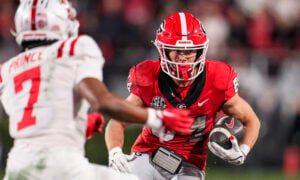Dynasty Fantasy Football Startup Draft Strategy

In this article, I’ll focus on the dynasty startup, specifically the basics of how to leave the draft with an advantage over your leaguemates. I’ll also highlight how to use DLF’s tools, content, rankings, and more to help you through it all.
Let’s jump into it!
The Dynamics
Before winning your dynasty startup, it’s essential to understand the environment that you’re entering. A dynasty startup is the only time during the lifetime of a dynasty league when all the players are readily available. For that reason, it’s also the time with the most trades, the most activity, and the most opportunities to exploit the psychology of that situation.
After the startup concludes, trading settles down, especially in today’s dynasty market. These days, there’s so much information available, especially with sites like DLF that provide everything you could want on one platform. Once managers have selected their players and their approach to team-building in the startup, they often don’t want to deviate or make many moves, causing a lull in trading.
Specifically, most people suffer from anchoring bias, which means it’s challenging to move perception from the first piece of information, even if circumstances have changed since that piece of information. In the context of a dynasty league, managers become attached to the startup price they or another manager paid for a particular player, inhibiting the trade market. Therefore, due to that anchoring, it’s crucial to hit the other managers during the startup to maximize your team’s future outlook.
Know The Market
The best way to know the market is by exploring DLF’s market resources. Let’s start with the ADP data, which comes in 1QB and superflex versions. For example, examine the first round of the 1QB data.
As you can see, almost all these players are younger assets outside Christian McCaffrey and Tyreek Hill. Of course, younger players are more valuable in dynasty leagues, as you get to keep your entire roster from year to year.
Unfortunately, there isn’t much actionable data in the first round other than helping to identify some tiers. Justin Jefferson and Ja’Marr Chase were the first two players taken in that order in every single mock draft. However, the situation becomes muddier after that, as Bijan Robinson fell from third to seventh overall, and CeeDee Lamb ranged from third to tenth. As you go down the draft board, variance increases even more, as Tyreek Hill fell anywhere from the ninth to the 24th pick, for example.
Let’s now use this opportunity to bring in a second source of data, DLF’s expert rankings.

When looking at these rankings, you can see some similarities between them and the ADP data. Jefferson, Chase, Lamb, Robinson, and AJ Brown are the top five players in both data sets. However, the ranks favor younger players more than the ADP data, as McCaffrey and Hill don’t appear in the rankings list.
It’s essential to take this moment to note the significant difference between ADP and rankings as a data source. ADP represents the value at which one manager was willing to select a player. Therefore, older players tend to fall higher in ADP, as almost every dynasty league has at least two or three managers who treat it more like a redraft league. However, dynasty rankings lists are an average of analysts and represent the mean value. But rankings don’t necessarily mirror what happens in real leagues, as they come from a tiny set of people.
But, of course, those are simply two data sources to consider. DLF’s website contains many other tools for research. First and foremost, I suggest using the Trade Finder and Trade Analyzer to familiarize yourself with trade values. Additionally, if you want to learn more about specific players and their statistics, the Yearly Data App and the Player Scoring History App are my two favorites. They are omnipresent in my articles, and they’ve helped me become both a better analyst and a better dynasty manager. Lastly, I suggest reading as many DLF articles as you can. They’ll help you learn about players, but they’ll also help you take in different dynasty perspectives.
Create Your Own Cheat Sheet and Win Your Startup
Therefore, to ensure the best possible outcome for your dynasty startup, creating your own cheat sheet is crucial. To help you get started, I suggest combining DLF’s ADP and rankings data to give you a baseline. Creating your own rankings list can be intimidating, but having a starting point can make a difficult task seem more manageable.
Then, incorporate your player takes, combined with information from DLF’s other tools, articles, and your outside research. Additionally, as you’re familiar with the trade market from the trade tools, you’ll be ready to trade within the startup. Gaining value from trades is just as important as picking the right players, as that’s how you create a dynasty, not just a good team.
Overall, I hope this article helped you understand how to do well in startups, and I hope you enjoyed it!
- Forgotten Dynasty Youth: Top Tier - March 27, 2024
- NFL Expiring Contracts In 2025: Tight End - February 25, 2024
- NFL Expiring Contracts In 2025: Wide Receiver - February 18, 2024


































































